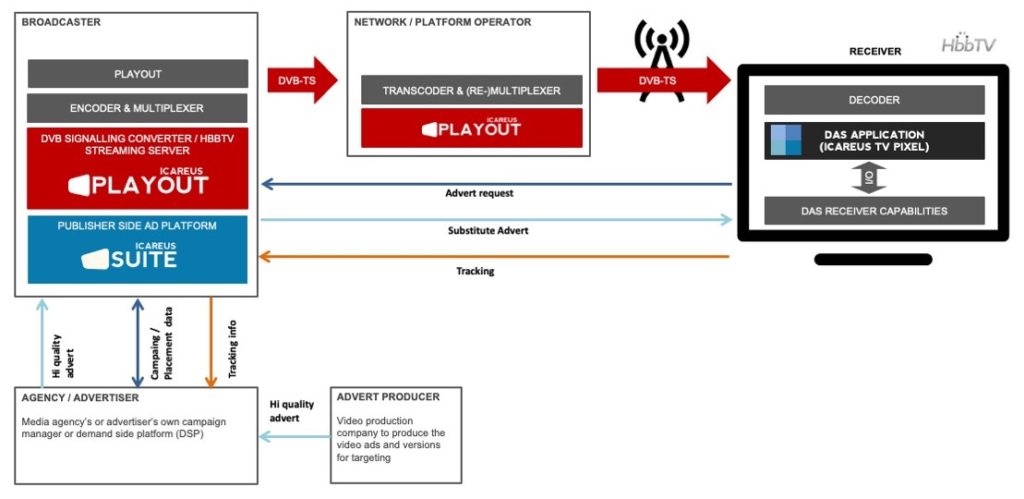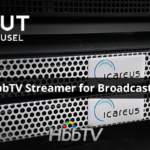What is DVB-TA? (Targeted Advertising)
blogs, Icareus AddressableTV, Icareus HbbTV Solutions, Icareus OTT, Icareus Playout, Icareus Playout - Carousel, Icareus SuiteDVB-TA is the new specification by DVB Project that defines a technical framework to offer dynamic ad substitution on broadcast networks. It is an good initiative to bring economies of scale and interoperability between different ad and broadcast platforms.
To Whom?
Should you read any further? Yes if you are a broadcasters who wishes to dynamically substitute advertising in a linear broadcast, or a platform operator who wishes to enable that functionality for broadcasters. You might also be an advertiser or media agency looking to improve your media spend on TV.
The Why?
Advertising is the revenue for broadcasters, but as it is moving to online and mobile with different business models, broadcasters need to (re)invent linear advertising to compete with digital giants, hence targeted advertising for live broadcast TV.
Advertisers have grown used to last minute changes on their digital campaigns, why shouldn’t TV offer the same?
More and more of them also want instant analytics how campaigns are performing on all platforms, it’s all about the data.
From technical perspective broadcasts’ reliability is pretty much 100%. However, as-soon-as you start introducing Internet, SmartTVs, ad-tech platforms and real-time operations for millions of simultaneous users, you start having challenges.
So, how can we move from showing the same TV spot to all, to a personalised (targeted) TV Spot to each viewer.
How to ensure that the linear TV experience isn’t broken by flickering screen, loading spinners or other glitches?
The TV Spot is, after all, at the same time for all the viewers and the TV program continues regardless how long it takes to load+buffer+play a video ad from Internet. Yep, the seamless dynamic ad insertion (DAI) or dynamic advert substitution (DAS) has its perks, but also its challenges. It is not just the technology, but also about viewer experience and finally, advertisers are quite keen to know how well their ads play on TV, it is all about their brand.
In my opinion Mr. Vincent Grivet, the ex-co-chair of the DVB’s CM-TA (Commercial Module for TA) group, summarised the reasoning well when they were working on the specification:
“There is a genuine appetite for targeted advertising to be made available for classical broadcast television. This is accompanied by the overall feeling that, with too many technical solutions, there is a risk of fragmentation in the marketplace that would hinder any progress.”
What is DVB-TA all about?
The standard is done with hope to create a common technology stack across markets, not only Europe. This should quicken the market adoption, replace the various proprietary solutions and thus increase the reach, which is vital for advertisers to adopt this new opportunity. As an example to tap pan-European digital campaign budgets, a quadrant of broadcasters have formed the European Broadcast Exchange (EBX).
It is not just DVB that is working on similar topics, but there are more commercial initiatives tackling the same standardisation challenge in U.S.: On Addressability (http://www.onaddressability.com) and Open Addressable Ready (https://projectoar.org)
This is what DVB-TA tries to do via defining technical tools and technical framework to improve the broadcast TV Spots. For some reason I’d call it rather a framework than standard as it leaves more freedom to the implementor than a full fledged standard (but I am an engineer).
It tries not to invent the wheel again and use what is available instead of defining everything from “scratch”. From this perspective is not a tradition technical standard but rather a specification that sets requirements for signalling and CE device as well as measurement and privacy. Positively it also discusses on different approaches in achieving dynamic ad substitution (DAS) and addresses some of the technical challenges as well as tradeoffs between quality and reach.
The technical framework for the DVB-TA will be built on HbbTV (www.hbbtv.org), a platform aimed at harmonising broadcast and broadband delivery and is in widespread use across Europe and also by broadcasters in Australia and the Middle East.
DVB-TA is split into two parts:
- Part 1: Ad server integration
- Part 2: Signalling spec
I will discuss both parts individually below.
Part 1 handles what happens when the ad trigger via broadcast is received. It covers things like Ad Request (although doesn’t define the format), Ad Response, Measurement & Reporting. It should be noted that the regulatory and legal aspects are out-of-scope for the DVB-TA specification/framework.
Everything is based on VAST format, matching the advert media with the one from the broadcast. VAST format also facilitates the possibility to use e.g. nested responses and reporting, which are both set as requirements also in DVB-TA. For custom use-cases, DVB-TA recommends the usage of VAST -tag.
Ad Pods, commercial breaks on TV, or stand-alone Ads, are the entities that are being substituted. DVB-TA recommends to use VAST instead of VMAP from IAB to describe the substituted ads. Without going to details, VAST provides a list of video files/urls that should be played instead of the linear ads. In addition to video, DVB-TA proposes mechanism to make a TV spot interactive via “VAST Interactive Templates” and react to call-to-actions like e.g. Icareus addressableTV display ad formats SwitchIn and ActiveAd.
Targeting is referenced only very vaguely and it merely states that an identifier for a TV or Viewer should be generated to enable targeting.
From viewer perspective the video quality makes a huge difference. For this reason DVB-TA recommends that the ad quality minimum matches the broadcast quality. This means that in adaptive streaming the lowest video profile should be of enough high quality. This means that the receiver should take into account also the IP network quality and whether to try to play the ad or not. Based on our experience TVs’ decoders are different and in some you need to rely on progressive download and some can also support adaptive streaming using DASH. The substitution latency can also depend on the video format that is used for the ad, encoder needs to switch from MPEG-TS to e.g. MP4/h.264, that may cause additional latencies.

Figure above illustrates the logical components found in the technology framework proposed by DVB to enable Targeted Advertising (DVB-TA) – source DVB-TA standard
Implementations for dynamic ad substitution rely heavily on (high-end) receiver capabilities and it will be interesting to see how manufacturers adopt the technical requirements set in DVB-TA. While one of the requirements is that one advert can be fully pre-loaded (=extra cost for manufacturer to provide storage), a broadcaster can also stream advert media rather than fully preload it. Streaming may be a useful approach as surely not all TVs will comply with a built-in storage. Personally I believe that to achieve enough reach (on horizontal markets) there will be a need to implement various “bumper” concepts to achieve a good user-experience as frame-accuracy will not be achievable in the near future.
Part 2 is all about broadcasting and how to convey the triggers to TVs to do the ad-replacement. Basically it sets a framework to transmit an SCTE-104 marker in a SDI signal via a digital head-end to a HbbTV application.
According to the SCTE 104 and SCTE 35 standards, broadcast events such as Programmes, Chapters, Breaks, Advertisements and many more can be signalled in a frame-accurate manner. This is naturally the level of accuracy that should be the target. Advertisement segments are then used to indicate opportunities for dynamic ad substitution (DAS). Splicing is another approach that can be used to trigger the ad replacements and it is based on “triggers” using the splice_insert() method. This is more widely used and would also match better to the logic related to stream-event generation.
Below is a figure the showing the signalling workflow. It should be noted that as of today HbbTV receivers do not have support for SCTE-35, thus the conversion to DSM-CC stream-event with platforms like Icareus Playout is mandatory. Alternatively e.g. Icareus Playout offers other triggering options via tcp and https based APIs. In vertical market an operator may utilise directly also the SCTE-35 as they can have full control on the receiver’s software and interfaces. SCTE-35 can also be used on local head-ends to do splicing directly to the regional broadcast stream to achieve regional targeting.

The value of DVB-TA is that it sets some recommendations on the format and way to convert the SCTE-35 to a stream event. hopefully this will result into more interoperability between different solutions. As an example Icareus Addressable TV solution is based on a proprietary payload format within a stream-event as it was deployed prior to the introduction of DVB-TA. Custom formats also enable us to provide enhanced features to our customers.
All in all, I would say that part 2 is more specific and like a “broadcast standard” with more details on the implementation. However it only has one approach for signalling based on SCTE-35 although there is a world of other options to do the triggering directly from broadcaster’s playout automation systems. These message formats could also be specified to match advertisers requirements, but are not left out. Part 1 is more a document describing a possible framework for dynamic ad substitution and list of requirements for the receivers. It leaves out completely the display advertising formats, which are significantly easier to deploy from technical perspective and are already being used widely across different markets.
The challenges (always are)
Albeit targeted advertising / addressable TV is already deployed in many countries there are still technical challenges to do dynamic ad substitution, the only format DVB-TA addresses. Simply put, biggest hurdle as of today is the lack of support from CE manufacturers, where is the beef for them? DVB-TA requirements mean high-end devices, which translates to high manufacturing costs. It is not about 4K or Smart portal functionalities, which can be differentiators between manufacturers, it is “just” about DVB-TA and it is the broadcaster who will collect all the benefits via higher ad revenues. Whether there will be agreements between broadcasters and CE manufacturers will remain to be seen.
Also HbbTV apps do not have access to SCTE 35 signalling. It means that an alternative way to trigger the ad substitution on devices has to be used. For the receiver there are basically three options to get the advert trigger: via DSM-CC stream-events, http sockets or using timestamps over internet. I would very strongly recommend DSM-CC Stream-events (don’t hesitate to contact me to hear why). Stream-events can be generated with e.g. Icareus Playout by triggering it via SCTE-35 or via other API (TCP or HTTP usually).
Last but not least, frame accuracy is a term I keep hearing. The substitution should be frame-accuracy, right? I am 100% sure that most devices will not offer this as they cannot decode simultaneously both broadcast stream and substituted ad, due to latency in decoder when switching back and forth. It should also be kept in mind that on some markers there must be black between ads and on some no.
How will DVB-TA be succesfull
I believe DVB-TA has all the possibilities to be used widely, but to see a end-to-end deployment that fulfils it 100%, I doubt in the near future.
DVB-TA is just a technical framework for dynamic ad substitution, and in my opinion and in a larger scope, for targeted advertising to become a success the following requirements should happen:
- Reach – there needs to be enough high-end receivers to be able offer acceptable user experience (and I do not mean frame-accuracy).
- Data collection – in GDPR compliant way, but still to offer enough datapoints for targeting
- Easy buying – broadcasters should agree upon ad-formats that can be purchased in similar fashion as digital ads. There should be “on-click” purchase option offered to media buyers via the own tools (demand side platforms).
Above to happen will require open mind and innovation from all parties involved, broadcasters, operators, media agencies and advertisers.
I am here for you, please be in touch and challenge me!
Further Reading
- Mikko Karppinen’s webinar: Making Addressable TV happen
- DVB BlueBook A178-1
- DVB BlueBook A178-2
For additional material we have provided you the following documents for download
Icareus Playout HbbTV streamer presentation
Product Presentation
Icareus Addressable TV presentation
Product Presentation
Register to our Knowledgebase to get all the latest documentation, free downloads and tips & tricks to use Icareus Playout
Don’t hesitate to contact for additional information



